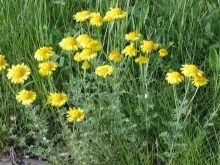All about the Roman chamomile

Since childhood, everyone knows the name of a light delicate flower with a yellow center and white petals. It's a chamomile. However, no one thinks that there are several types of chamomiles, and each variety has its own characteristics. Let's take a closer look at one of the types of chamomile - Roman chamomile or navel.
Peculiarities
It is a garden flower that is a perennial, biennial, or annual. The leaves and inflorescences of the presented culture are almost indistinguishable from ordinary chamomile, however, the Roman species has a special variety - this is a flower with yellow petals, and for this feature, the navel can be easily distinguished from the traditional chamomile.
Roman chamomile is an excellent prophylactic agent that has a calming and choleretic effect. It relieves the condition of the body with inflammation and can even be recommended for children during teething and colic. The culture can also be used in cosmetology, it softens the dermis, relieves swelling, removes dark spots under the eyes.
Roman chamomile is used in the treatment of neuroses and insomnia, its flowers soothe the nervous system, and an ingredient from the navel can be found in hair care products.


There are several varieties of the plant.
- Noble navel. A medicinal plant that has the same properties as chamomile. Miniature bush, only 25 cm in length, can be used as a ground cover crop.
- Pupavka is Cretan. It reaches a height of 30 cm, the leaves are covered with white or gray pile, also looks like an ordinary chamomile.
- Pupavka is dyeing. This bush is distinguished by its high growth - up to 70 cm, has serrated leaves, as well as completely yellow inflorescences, from which a dye can be obtained.



Landing
Planting is carried out in spring and autumn. The culture grows well, therefore, it is customary to leave a distance of at least 30-40 cm between two specimens. For planting, carbonate or calcareous soils are suitable, and in Egypt this variety develops well even in sand.
It is allowed to grow the plant in containers, in this case, simple garden soil is suitable for planting. For planting on the site, give preference to beds located in the sun.


Care
The main care is reduced to watering and feeding. This variety can withstand drought without any problems, but if the dry period lasts a long time, then watering will definitely not be superfluous. It is important not to overdo it with moisture, otherwise it will inevitably lead to decay of the roots. Every year, the garden bed is fertilized with humus, peat and compost, and in mid-April, ammonium nitrate is used.
The plant can fall prey to snails and slugs. To prevent their appearance, you need to carry out prevention: regularly mow the grass, weed the area where chamomile grows. It is especially necessary to get rid of nettles and branches in which harmful individuals can hide. Loosening is also a preventive method, during which snail eggs are hatched and dried in the sun.
Another method of protection against mucus and snails is with crushed eggshells, which can be scattered around the garden. As a preventive measure, plant garlic, mustard, marjoram next to the site.


You can grow the presented variety through seeds or through seedlings. Dilution by cuttings is allowed, which must be prepared in the second half of summer, and then planted in a peat-sandy substrate and grown in conditions of high air humidity.Reproduction is also practiced by dividing the bush: neatly cut parts are immediately moved to a new place.
Low-growing species of Roman chamomile are suitable for growing on alpine slides, they can become an original living border or emphasize the beauty of a mixborder. No matter how the navel bushes are located on the site, they will give the garden a beautiful, well-groomed and romantic appearance.










































































































The comment was sent successfully.